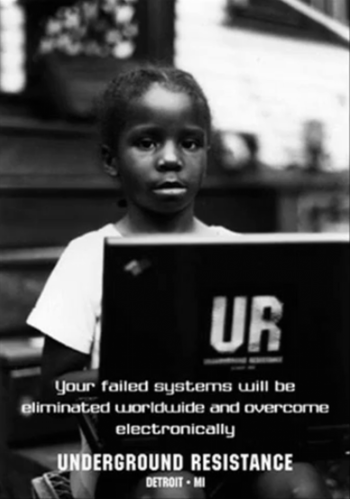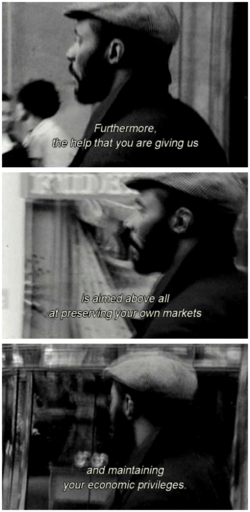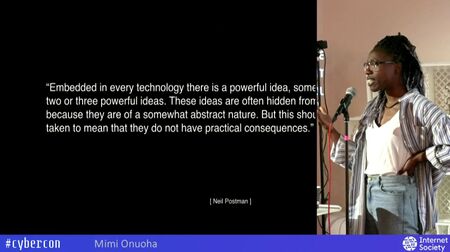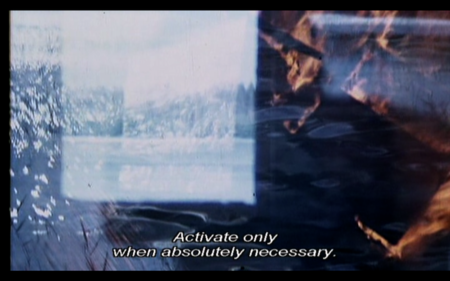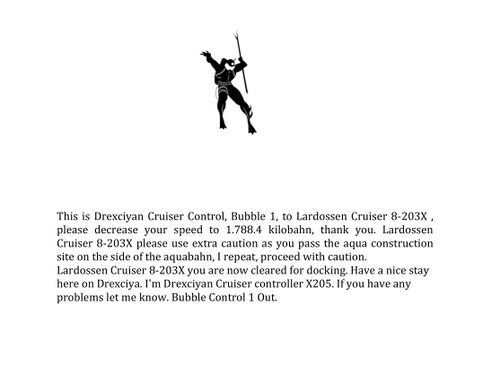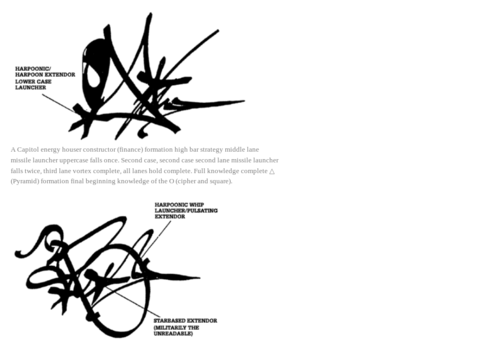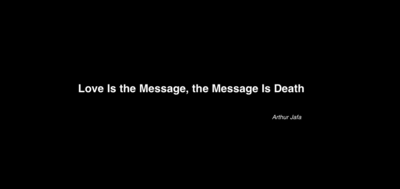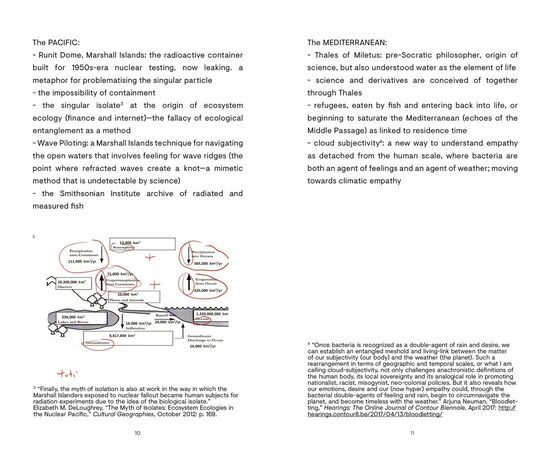User:E.zn/Methods3
'I don’t think we’re ever going to get to utopia again by going forward, but only roundabout or sideways; because we’re in a rational dilemma, an either/or situation as perceived by the binary computer mentality, and neither the either nor the or is a place where people can live.' -- Ursula K. Le Guin
--
- ⌗ Mindy Seu - Cyberfeminist Index [~1990s-present]
- ⌗ Addie Wagenknecht - Alone Together
- ⌗ Henry Cooke & Tim Cowlishaw - I Am Running In The Cloud [after Alvin Lucier's 'I am sitting in a room']
- prehensile.github.io/blog/2018/02/17/running-in-the-cloud.html
- ~ Books with an Attitude : constantvzw
- ~ Library Stack
- ~ Critical Engineering
- ~ Mindy Seu - PDF Library // are.na
- ~ Mindy Seu - Queer OS // are.na
- ~ hyperreadings
⯐
- ⯐ Deep Lab Lecture Series: Addie Wagenknecht, Allison Burtch, Runa Sandvik, Harlo Holmes, Ingrid Burrington, Maral Pourkazemi, Denise Caruso, Lindsay Howard, Maddy Varner, Jen Lowe, Lorrie Faith Cranor
- ⯐ Cybernetics Conference: Wendy Chun, Paul Pangaro, Shannon Mattern, Adrian Chen, McKenzie Wark, Paul Soulellis, Frank Pasquale, Mimi Onuoha, Zabet Patterson, Allison Parrish, Michael Yap, Lars TCF Holdhus
- ⯐ Recontextualizing Type in Motion: Mindy Seu at the San Francisco Public Library
- ⯐ Arthur Jafa [In Your Face : Interview]
- ⯐ Anja Kanngieser - Listening to Ecocide
- ⯐ Kodwo Eshun - After Year Zero [Geographies of Collaboration since 1945]
- ⯐ Ruth Wilson Gilmore: Geographies of Racial Capitalism -- src
- ⯐ Med Hondo - Soleil O
- Documentaries:
- ⯐ James Baldwin : The Price of the Ticket
- ⯐ Erkki Kurenniemi : The Future Is Not What It Used to Be [Mika Taanila]
- ⯐ Into Eternity [Michael Madsen]
- ⯐ Milford Graves : Full Mantis
- ⯐ Ornette : Made in America
- ⯐ Rare Earthenware [Unknown Fields]
- ⯐ Project Tierra
My reading list for SIXII
- __Fred Moten - Black and Blur
Held in the very idea of white people — in the illusion of their strength, in the fantasy of their allyship, in the poverty of their rescue, in the silliness of their melancholy, in the power of their networks, in the besotted rejection of their impossible purity, in the repeated critique of their pitiful cartoon — is that thing about waiting for vacancy to shake your hand while the drone’s drone gives air a boundary
- __Fred Moten’s Radical Critique of the Present
For Moten, blackness is something “fugitive,” as he puts it—an ongoing refusal of standards imposed from elsewhere. In “Stolen Life,” he writes, “Fugitivity, then, is a desire for and a spirit of escape and transgression of the proper and the proposed. It’s a desire for the outside, for a playing or being outside, an outlaw edge proper to the now always already improper voice or instrument.” In this spirit, Moten works to connect subjects that our preconceptions may have led us to think had little relation. One also finds a certain uncompromising attitude—a conviction that the truest engagement with a subject will overcome any difficulties of terminology. “I think that writing in general, you know, is a constant disruption of the means of semantic production, all the time,” he told me. “And I don’t see any reason to try to avoid that. I’d rather see a reason to try to accentuate that. But I try to accentuate that not in the interest of obfuscation but in the interest of precision.”
- __Ionic Treatise Gothic Futurism Assassin Knowledges Of the Remanipulated Square Point’s One to 720° to 1440° The RAMM-ΣLL-ZΣΣ
- __Andrea Sick, Claudia Reiche - Technics of Cyber ‹ › Feminism. ‹mode=message›
- __Juliana Huxtable - Mucus in My Pineal Gland
They had developed the most advanced systems for mapping desire known to man [literally]. They all seemed satisfied to live in a world of tops/bottoms, mascs/fems divided into various size, shape, hair level, affiliations. It was less a result of sexual exploration than a marketplace that mimicked the artificial volition offered by a shopping mall. The complexities of sensual want were denied prima facie in lieu of the easy, greasy, sleazy, and cheap alternative. Fucking or getting fucked for one night only... possibly more if you could tolerate his breath...
- __Helen Hester - Xenofeminism
- __Shulamith Firestone - Dialectic of Sex
- __Simone de Beauvoir - The Second Sex
- __Derek Jarman - At Your Own Risk
- __Frantz Fanon - A Dying Colonialism
The highly trained French services, rich with experience acquired in modern wars, past masters in the practice of "sound-wave warfare," were quick to detect the wave lengths of the broadcasting stations. The programs were then systematically jammed, and the Voice of Fighting Algeria soon became inaudible. A new form of struggle had come into being. Tracts were distributed telling the Algerians to keep tuned in for a period of two or three hours. In the course of a single broadcast a second station, broadcasting over a different wave-length, would relay the first jammed station.
[...]
Every evening, from nine o'clock to midnight, the Algerian would listen. At the end of the evening, not hearing the Voice, the listener would sometimes leave the needle on a jammed wave-length or one that simply produced static, and would announce that the voice of the combatants was here. For an hour the room would be filled with the piercing, excruciating din of the jamming. Behind each modulation, each active crackling, the Algerian would imagine not only words, but concrete battles.
- __Gerda Lerner - The Creation of Feminist Consciousness
- __Siegfried Zielinski - [...After the Media]
- __Alessandro Ludovico - Post-Digital Print
- __Yiannis Colakides, Marc Garrett, Inte Gloerich - State Machines
- __Taeyoon Choi - Poetic Computation [Reader]
- __Frank Pasquale - From Territorial to Functional Sovereignty: The Case of Amazon
- __Loes Bogers and Letizia Chiappini - The Critical Makers Reader: (Un)Learning Technology
- __Paul Virilio - The Aesthetics of Disappearance
- __Mark Fisher - Capitalist Realism
- __Shannon Mattern - Extract and Preserve [Underground Repositories for a Posthuman Future?]
- __Stokely Carmichael and Charles V. Hamilton - Black Power: The Politics of Liberation
- __Eldridge Cleaver - Soul on Ice
- __Alex Williams and Nick Srnicek - Inventing the Future
- __Naomi Klein - The Shock Doctrine
- __Fredric Jameson - The Political Unconscious
- __Eric Schrijver - Copy This Book: An Artist's Guide to Copyright
- __Josephine Bosma, Geert Lovink et al. - Readme! Filtered by Nettime: ASCII Culture and the Revenge of Knowledge
- __Deep Lab
- __Engine Failure: Safiya Umoja Noble and Sarah T. Roberts on the Problems of Platform Capitalism
- __L. M. Sacasas - One Does Not Simply Add Ethics To Technology
'Different ideas of social and political life entail different technologies for their realization. One can create systems of production, energy, transportation, information handling, and so forth that are compatible with the growth of autonomous, self-determining individuals in a democratic polity. Or one can build, perhaps unwittingly, technical forms that are incompatible with this end and then wonder how things went strangely wrong. The possibilities for matching political ideas with technological configurations appropriate to them are, it would seem, almost endless. If, for example, some perverse spirit set out deliberately to design a collection of systems to increase the general feeling of powerlessness, enhance the prospects for the dominance of technical elites, create the belief that politics is nothing more than a remote spectacle to be experienced vicariously, and thereby diminish the chance that anyone would take democratic citizenship seriously, what better plan to suggest than that we simply keep the systems we already have?' -- Langdon Winner [1977]
- __Feminist Data Manifest-No [A declaration of refusal and commitment. It refuses harmful data regimes and commits to new data futures]
1. We refuse to operate under the assumption that risk and harm associated with data practices can be bounded to mean the same thing for everyone, everywhere, at every time. We commit to acknowledging how historical and systemic patterns of violence and exploitation produce differential vulnerabilities for communities.
[...]
5. We refuse any code of phony “ethics” and false proclamations of transparency that are wielded as cover, as tools of power, as forms for escape that let the people who create systems off the hook from accountability or responsibility. We commit to a feminist data ethics that explicitly seeks equity and demands justice by helping us understand and shift how power works.
[...]
10. We refuse to “close the door behind” ourselves. We commit to entering ethically compromised spaces like the academy and industry not to imbricate ourselves into the hierarchies of power but to subvert, undermine, open, make possible.
- __As Brilliant as the Sun: Arthur Jafa
I make work that addresses black people. Some people find that statement troubling: they think I’m saying I don’t make work for white people, but it’s not the same thing. I’m speaking to black people and everybody else gets to listen in. By and large, our society is dominated by the positions and opinions of white people. If you go to see a movie, for instance, almost invariably it comes from the perspective of a white male subject. So, all the non-men and non-white folks who have to listen to this shit have developed an empathetic muscle which they use to project themselves into someone else’s subject position, to try and feel some of what they feel and perhaps understand how their world is structured. That muscle is profoundly underdeveloped in white men, so speaking to them specifically is not necessarily productive. It’s a position I share with Kerry James Marshall: a rejection of the implication that black-specific work cannot be universal. Culturally speaking, it’s a fundamental counter-assumption that a figure can be black and still represent all of humankind, or all men or all women.
- __McKenzie Wark - Black Accelerationism
- __Anja Kanngieser - Experimental Politics and the Making of Worlds
Suggested readings and references
````````````````````````````````````````````````````````
The plot of her undoing
- ``Saidiya Hartman - The plot of her undoing [Read collectively during the session]
- ``Seda Gurses - Apple & Google Partner to Promote Coronavirus Contact Tracing. Should You be Worried?
One World in Relation Edouard Glissant
A Giant Bumptious Litter
The mutual synchronisation of coupled oscillators
- ``Natalie Jeremijenko + Kate Rich Track 12: The mutual synchronisation of coupled oscillators [This was one track from a CD released as an "insert" to Mute Magazine: Vol. 1 No. 21 . September 2001]. The other tracks are available as well. In the recording, Jeremijenko speaks; the audio production/remix was done by Rich. They worked together as the Bureau of Inverse Technology.
Artificial intelligence: Warped, colorful forms and their unclear geometries
On Being Human as Praxis
- ``Sylvia Wynter - On Being Human as Praxis [interview with Katherine Mckittrick . 2015]
Mise en Valeur et Omission
- ``Elodie Mugrefya - Mise en Valeur et Omission [2019]
On difference without separability
- ``Denise Fereira Da Silva - On difference without separability [2016]
Mathematics Black Life
- ``Katherine Mckittrick - Mathematics Black Life
Imaginary Computational Systems: Queer Technologies and Transreal Aesthetics
- ``Zach Blas & Micha Carde - Imaginary Computational Systems: Queer Technologies and Transreal Aesthetics [2015]
While Turing considered gender in the Turing test, his homosexuality seems quite separate from his scientific research, although Homay King has recently suggested that Turing’s work, especially the Turing machine, bears connection to his personal, erotic desire.
[...]
We extract from Turing and these feminist theorists the power to desire logics and to make those logics in order to construct alternatives. However, we differ from Turing in that we do not want a universal logic. Our logics are multiplicitous yet partial, erotic and embodied, uncompromising, and of the impossible. We like Deleuze’s comment that ‘‘universals of communication ought to make us shudder.’’
[...]
We are intrigued by the Turing machine as a diagram, an abstraction. The Turing machine, importantly, is separate from the binary computational logic running on digital devices — it is an abstraction of that logic. The Turing machine, on its own, requires a bit of performativity and imagination. In a recent episode of Radiolab, the Turing machine was described as ‘‘the world’s most impractical machine, ’’noting that one of its requirements is never-ending tape. We savor these small, impractical components of the Turing machine — these components that require one to imagine a logic — to imagine how a machine might perform.
[...]
What might the racial logics underpinning the Turing machine be? A product of the mind of a dedicated military code-breaker for the british empire, can we understand the Turing machine to represent the imperial drive for global conquest? Perhaps the name the Universal Turing machine best represents the racial and cultural assumptions of the Turing machine. The machine begins by thinking that any problem can be encoded into symbolic logic and thus computed.
[...]
Returning to Tara McPherson’s urging to understand the systems that underlie contemporary representations of culture, perhaps what these examples of queer media art reveal is that contemporary computing is strongly shaped by the desires and interests of corporations. In contrast to Turing’s time, when technology could be best understood as an outgrowth of the state military apparatus, today’s technologies are products of globalizing neoliberalism and, therefore, are powerfully centered in the interests of multinational corporations. The limitations of computers being designed for linguistic, emotional, and physical appropriateness of the workplace, from programming languages to physical interfaces, both reveal that the form of the contemporary computer is still defined by the demands of the neoliberal capitalist workplace. As new forms of computing develop, such as tablet and cloud computing, one can see a radically more controlled form of society being reflected, one in which all software installed on a computer must be approved by a computer manufacturer.
- - Micha Cárdenas & Elle Mehrmand - virus.circus
Reveals another limitation of the supposed universality of systems that are computable or decidable by the Turing machine.
[...]
In virus.circus.laboratory, an imaginary system with a direct cortical interface, facilitated by nanobiotechnology, gets its power from the chemical contents of ejaculate fluid, including glucose and fructose (Nano Patents and Innovations, 2010). By imagining such a system, virus.circus.probe highlights the moment when the Turing machine advances the tape and asks how is the tape advanced? By what power source? It reveals the assumptions of a western imperialist system of thought that would assume that power is in infinite supply, and therefore any string is computable by a Turing machine. Instead, virus.circus.probe reveals the corporate-oriented concerns and desires of contemporary computing interfaces by asking, what if computers required a heightened emotional state in order to function, or a state of sexual pleasure and satisfaction?
- - Micha Cárdenas & Elle Mehrmand - virus.circus
Queer technologies is an organization that produces a product line for queer technological agency, interventions, and social formation. It aims toward automating perverse possibilities.
Queer technologies identifies its larger discursive practices as a viral aesthetics, in that it encrypts itself within flows of capital to replicate/permeate itself in relation and tension to capital’s own modulating, viral structure.
- - Zach Blas - Gay Bombs [users.design.ucla.edu/~zblas/thesis_website/gay_bombs/GB_book.pdf]
Gay Bombs is a technical manual manifesto that outlines a “how to” of queer networked activism. Gay Bombs is a reverse discourse, a re-inscription, a mutating body politic, a multitude, a queer terrorist assemblage of networked activists, deploying new technologically queer sensibilities. Gay Bombs is a technical manual designed to explicate and frame the discourses of Queer Technologies. In this userʼs guide, a “how to” of queer political action and formation is outlined through the use and distribution of Queer Technologies. Topics include: understanding queer technological tactics, creating and organizing, working with consumerism, and managing output.
- - Zach Blas - Gay Bombs [users.design.ucla.edu/~zblas/thesis_website/gay_bombs/GB_book.pdf]
- - Zach Blas - transCoder [Queer Programming Anti-Language] -- Code Libraries
transCoder is programmed to transcode between Manovich’s cultural layer and computer layer. Specifically, as queer programming anti-language, transCoder offers libraries rooted in theories of queerness as an attempt to severe ontological and epistemological ties to dominant technologies and interrupt the flow of circulation between heteronormative culture, coding, and visual interface.
- - Zach Blas - transCoder [Queer Programming Anti-Language] -- Code Libraries
Butler's Destabilization Loop (Citing the Other)
breaks apart any process that acts as a continuously iterating power
destabilizationLoop()
will not function with any pre-determined logic or syntax
genInsub()
Haraway's Taxonomies for a Genderless Future
deletes all semantically identified language that is representative of gender binaries and sets everything in the program equal to itself
metametazoan
collapses an epistemological interpretation of syntax to incite deviation from official notions of a processual experience of computation
noTax()
Sadie Plant's 0 as 1 [Fuck Lacan]
can be assigned any relational operator (<, >, etc.) to fracture the Imaginary
lack
multiples by an unknown mutant number
xxxxy
- - Race after the Internet - Edited by Lisa Nakamura and Peter Chow-White
- - Micha Cárdenas - Ch. 1: Tara McPherson, "U.S. Operating Systems at Mid-Century"
CompuQueer
- ``Noah Tsika - CompuQueer: Protocological Constraints, Algorithmic Streamlining, and the Search for Queer Methods Online [2016]
Race and/as Technology; or, How to Do Things to Race
- ``Wendy Hui Kyong Chun - Race and/as Technology; or, How to Do Things to Race [2009]
A Brief Introduction to Decolonial Computing
- ``Syed Mustafa Ali - A Brief Introduction to Decolonial Computing [2016]
Re-imagining communities
- ``Sara Ahmed & Anne-Marie Fortier - Re-imagining communities [International Journal of Cultural Studies . 2003, Volume 6[3]: 251–259]
Eventual consistency
- ``Michael Murtaugh - Eventual consistency
Black Feminist Calculus Meets Nothing to Prove
- ``Alexis Pauline Gumbs & Julia Roxanne Wallace - Black Feminist Calculus Meets Nothing to Prove: A Mobile Homecoming Project Ritual toward the Postdigital [P. 305]
Digital Neocolonialism and Massive Open Online Courses
- ``Taskeen Adam - Digital Neocolonialism and Massive Open Online Courses [MOOCs: Colonial Pasts and Neoliberal Futures [2019]]
She Unnames Them
- ``Ursula Leguin - She Unnames Them [1985]
A couple of problems did come up with pets. The cats, of course, steadfastly denied ever having had any name other than those self-given, unspoken, ineffably personal names which, as the poet named Eliot said, they spend long hours daily contemplating though none of the contemplators has ever admitted that what they contemplate is their names and some onlookers have wondered if the object of that meditative gaze might not in fact be the Perfect, or Platonic, Mouse. In any case, it is a moot point now.
[...]
None were left now to unname, and yet how close I felt to them when I saw one of them swim or fly or trot or crawl across my way or over my skin, or stalk me in the night, or go along beside me for a while in the day. They seemed far closer than when their names had stood between myself and them like a clear barrier: so close that my fear of them and their fear of me became one same fear. And the attraction that many of us felt, the desire to feel or rub or caress one another’s scales or skin or feathers or fur, taste one another’s blood or flesh, keep one another warm -- that attraction was now all one with the fear, and the hunter could not be told from the hunted, nor the eater from the food.
Four Waters: Deep Implicancy
- ``Denise Ferreira Da Silva & Arjuna Neuman - Four Waters: Deep Implicancy [2019]
4 Waters – Deep Implicancy is as much a film project and an experiment in collaboration as it is a set of fragments drawn from a reimagined cosmos.
These fragments, sounds, and stories help us convey the experiential moment of entanglement, or rather, they describe an entangled moment prior to separation, what we call “Deep Implicancy”.
One such story we follow is water, both as it phase transitions with and into other matter including life, but also as it combines disparate geographies, bodies of/in water, and four islands within them – Lesvos, Haiti, Marshall Islands, Tiwi.
Through a series of experimental migrations and elemental crossings we begin to question the form of the universal human, its calcified and exceptional origins, and in particular its ethical program.
Wandering and wondering through a transformative figuring of justice, we ask, what if our image of the world recalled phase instead of measure? And what becomes of ethics if we let go of value?
- - Cryptochrome and Magnetic Sensing
The avian magnetic compass is a complex entity with many surprising properties. The basis for the magnetic sense is located in the eye of the bird, and furthermore, it is light-dependent, i.e., a bird can only sense the magnetic field if certain wavelengths of light are available. Specifically, many studies have shown that birds can only orient if blue light is present. The avian compass is also an inclination-only compass, meaning that it can sense changes in the inclination of magnetic field lines but is not sensitive to the polarity of the field lines. Under normal conditions, birds are sensitive to only a narrow band of magnetic field strengths around the geomagnetic field strength, but can orient at higher or lower magnetic field strengths given accommodation time.
[...]
Despite decades of study, the physical basis of the avian magnetic sense remains elusive. The two main models for avian magnetoreception are a magnetite-based model and a radical-pair-based model (for review see, e.g., Solov'yov, Schulten, Greiner, 2010). The former suggests that the compass has its foundation in small particles of magnetite located in the head of the bird. The latter idea is that the avian compass may be produced in a chemical reaction in the eye of the bird, involving the production of a radical pair. A radical pair, most generally, is a pair of molecules, each of which have an unpaired electron. If the radical pair is formed so that the spins on the two unpaired electrons in the system are entangled (i.e. they begin in a singlet or triplet state), and the reaction products are spin-dependent (i.e., there are distinct products for the cases where the radical pair system is in an overall singlet vs. triplet state), then there is an opportunity for an external magnetic field to affect the reaction by modulating the relative orientation of the electron spins.
[...]
The question remains as to where, physically, this radical pair reaction would take place. It has been suggested that the radical pair reaction linked to the avian compass arises in the protein cryptochrome. Cryptochrome is a signaling protein found in a wide variety of plants and animals, and is highly homologous to DNA photolyase.
- - Cryptochrome and Magnetic Sensing
- - Birds measure magnetic fields using long-lived quantum coherence
Long-lived spin coherence in proteins found in the eyes of migratory birds could explain how the creatures are able to navigate along the Earth’s magnetic field with extraordinary precision.
[...]
One of the most popular theories is based on the idea that incoming photons excite light-sensitive proteins called cryptochromes in the retina of a bird’s eye. This results in an electron being transferred between two molecules within the protein. The two resulting free-radical molecules each have an unpaired electron but, because they were produced simultaneously, the spins of the two electrons are correlated. The two electron spins form a coherent quantum state that is affected by weak external magnetic fields, such as the geomagnetic field. This interaction affects the chemical reactivity of the free-radical molecules and ultimately the signals that they send to the brain.- -- Quantum Coherence
- - Birds measure magnetic fields using long-lived quantum coherence
- pwd:hand
Cloud >> memory
Four Rooms – Elizabeth A. Povinelli
- ``Four Rooms – Elizabeth A. Povinelli - On Virus and Interdependence of Lives [2020]
- - Raafat Majzoub
- -- The Khan
The Khan started as a generative, transnational place in The Perfumed Garden, referred to as Khan El Thawra, or the khan of the revolution—and later developed into an experimental NGO registered in Lebanon under the title The Khan: The Arab Association for Prototyping Cultural Practices.
In the novel, Khan El Thawra references Khans present in historical Arab cities…- -- The Perfumed Garden [Read]
- -- Writing as architecture: Performing Reality Until Reality Complies
- - Raafat Majzoub
- - Elizabeth A. Povinelli
- -- 'Either your thoughts are practices, or they are not thoughts'
- -- Geontologies: A Requiem to Late Liberalism
'The Virus is the figure for that which seeks to disrupt the current arrangements of Life and Nonlife by claiming that it is a difference that makes no difference not because all is alive, vital, and potent, nor because all is inert, replicative, unmoving, inert, dormant, and endurant. Because the division of Life and Nonlife does not define or contain the Virus, it can use and ignore this division for the sole purpose of diverting the energies of arrangements of existence in order to extend itself. The Virus copies, duplicates, and lies dormant even as it continually adjusts to, experiments with, and tests its circumstances. It confuses and levels the difference between Life and Nonlife while carefully taking advantage of the minutest aspects of their differentiation. We catch a glimpse of the Virus whenever someone suggests that the size of the human population must be addressed in the wake of climate change; that a glacial granite mountain welcomes the effects of air conditioning on life; that humans are kudzu; or that human extinction is desirable and should be accelerated'
- --- Marjie Short - Kudzu [src]
- - Elizabeth A. Povinelli
- - Anna Tsing
- -- The Mushroom at the End of the World
'Might it encounter the roots of a receptive tree? A change in substrate or potential nutrition? Through its indeterminate growth,the fungus learns the landscape. There are humans to encounter as well. Will they inadvertently nurture the fungus while cutting firewood and gathering green manure? Or will they introduce hostile plantings, import exotic diseases, or pave the area for suburban development? Humans matter on these landscapes. And humans (like fungi and trees) bring histories with them to meet the challenges of the encounter. These histories, both human and not human,are never robotic programs but rather condensations in the indeterminate here and now;the past we grasp,as philosopher Walter Benjamin puts it,is a memory “that flashes in a moment of danger“'
- - Anna Tsing
- - Saidiya Hartman
- -- Scenes of Subjection [4. The Burdened Individuality of Freedom]
The limits of political emancipation appear at once in the fact that the state can liberate itself from constraint without man himself being really liberated; that a state may be a free state without man himself being a free man. -- Karl Marx, On the Jewish Question [1843]
The emancipation of the slaves is submitted to only in so far as chattel slavery in the old form could not be kept up. But although the freedman is no longer considered the property of the individual master, he is considered the slave of society. -- Carl Schurz, Report on the Condition of the South [1865]
Are we to esteem slavery for what it has wrought, or must we challenge our conception of freedom and the value we place upon it? -- Orlando Patterson, Slavery and Social Death [1982]
The entanglements of bondage and liberty shaped the liberal imagination of freedom, fueled the emergence and expansion of capitalism, and spawned proprietorial conceptions of the self. This vexed genealogy of freedom plagued the great event of Emancipation, or as it was described in messianic and populist terms, Jubilee. The complicity of slavery and freedom or, at the very least, the ways in which they assumed, presupposed, and mirrored one another—freedom finding its dignity and authority in this “prime symbol of corruption” and slavery transforming and extending itself in the limits and subjection of freedom—troubled, if not elided, any absolute and definitive marker between slavery and its aftermath. The longstanding and intimate affiliation of liberty and bondage made it impossible to envision freedom independent of constraint or personhood and autonomy separate from the sanctity of property and proprietorial notions of the self. Moreover, since the dominion and domination of slavery were fundamentally defined by black subjection, race appositely framed questions of sovereignty, right, and power. The traversals of freedom and subordination, sovereignty and subjection, and autonomy and compulsion are significant markers of the dilemma or double bind of freedom. Marx, describing a dimension of this paradox, referred to it with dark humor as a double freedom—being free to exchange one’s labor and free of material resources. Within the liberal “Eden of the innate rights of man,” owning easily gave way to being owned, sovereignty to fungibility, and abstract equality to subordination and exploitation. If sovereignty served “to efface the domination intrinsic to power” and rights “enabled and facilitated relations of domination,” as Michel Foucault argues, then what we are left to consider is the subjugation that rights instigate and the domination they efface.
[...]
The advent of freedom held forth the possibility of a world antithetical to slavery and portents of transformations of power and status that were captured in carnivalesque descriptions like “bottom rail on top this time.” At the same time, extant and emergent forms of domination intensified and exacerbated the responsibilities and the afflictions of the newly emancipated. I have opted to characterize the nascent individualism of emancipation as “burdened individuality” in order to underline the double bind of freedom: being freed from slavery and free of resources, emancipated and subordinated, self-possessed and indebted, equal and inferior, liberated and encumbered, sovereign and dominated, citizen and subject.
[...]
The civil and political rights bestowed upon the freed dissimulated the encroaching and invasive forms of social control exercised over black bodies through the veneration of custom; the regulation, production, and protection of racial and gender inequality in the guise of social rights; the repressive instrumentality of the law; and the forms of extraeconomic coercion that enabled the control of the black population and the effective harnessing of that population as a labor force.
[...]
When we examine the history of racial formation in the United States, it is evident that liberty, property, and whiteness were inextricably enmeshed. Racism was central to the expansion of capitalist relations of production, the organization, division, and management of the laboring classes, and the regulation of the population through licensed forms of sexual association and conjugal unions and through the creation of an internal danger to the purity of the body public. Whiteness was a valuable and exclusive property essential to the integrity of the citizen-subject and the exemplary self-possession of the liberal individual. Although emancipation resulted in a decisive shift in the relation of race and status, black subordination continued under the aegis of contract. In this regard, the efforts of Southern states to codify blackness in constitutions written in the wake of abolition and install new measures in the law that would secure the subordination of freed black people demonstrate the prevailing disparities of emancipation.
[...]
The legacy of slavery was evidenced by the intransigence of racism, specifically the persistent commitment to discriminatory racial classifications despite the prohibition of explicit declarations of inequality or violations of life, liberty, and property based on prior condition of servitude or race.
[...]
“Burdened individuality” designates the double bind of emancipation—the onerous responsibilities of freedom with the enjoyment of few of its entitlements, the collusion of the disembodied equality of liberal individuality with the dominated, regulated, and disciplined embodiment of blackness, the entanglements of sovereignty and subjection, and the transformation of involuntary servitude effected under the aegis of free labor.
[...]
The mantle of individuality effectively conscripted the freed as indebted and dutiful worker and incited forms of coercion, discipline, and regulation that profoundly complicated the meaning of freedom. If it appears paradoxical that the nomination “free individual” illuminates the fractures of freedom and begets methods of bondage quite suited to a free labor economy, it is only because the mechanisms through which right, exchange, and equality bolster and advance domination, subjection, and exploitation have not been interrogated. Liberal discourses of freedom enable forms of subjection seemingly quite at odds with its declared principles, since they readily accommodate autonomy and domination, sovereignty and submission, and subordination and abstract equality. This can be attributed to the Lockean heritage of U.S. constitutionalism, which propounded an ideal of liberty founded in the sanctity of property, and the vision of liberty forwarded in the originary narrative of the Constitution, which wed slavery and freedom in the founding of the nation and the engendering of “we the people.”
[...]
it is necessary to consider whether the effort of the dominated to “take up” the universal does not remedy one set of injuries only to inflict injuries of another order. It is worth examining whether universalism merely dissimulates the stigmatic injuries constitutive of blackness with abstract assertions of equality, sovereignty, and individuality. Indeed, if this is the case, can the dominated be liberated by universalist assertions?
[...]
the transition from slavery to freedom cannot adequately be represented as the triumph of liberty over domination, free will over coercion, or consent over compulsion. The valued precepts of liberalism provide an insufficient guide to understanding the event of emancipation. The ease with which sovereignty and submission and self possession and servility are yoked is quite noteworthy. In fact, it leads us to wonder whether the insistent, disavowed, and sequestered production of subordination, the inequality enshrined by the sanctity of property, and the castigating universality of liberalism are all that emancipation proffers. Is not the free will of the individual measured precisely through the exercise of constraint and autonomy determined by the capacity to participate in relations of exchange that only fetter and bind the subject? Does the esteemed will replace the barbaric whip or only act as its supplement? In light of these questions, the identity of the emancipated as rights bearer, free laborer, and calculable man must be considered in regard to processes of domination, exploitation, and subjection rather than in the benighted terms that desperately strive to establish slavery as the “prehistory” of man.
- - Saidiya Hartman
Four Rooms – Denise Ferreira Da Silva
- ``Four Rooms – Denise Ferreira Da Silva - On the Logics of Exclusion and Obliteration [2020]
Sun Ra
- ``Sun Ra
- - Brent Hayes Edwards - On The Race for Space: Sun Ra’s Poetry [Epistrophies from Jazz and the Literary Imagination]
- - John F. Szwed - Space is the Place: The Lives and Times of Sun Ra
- - Paul Youngquist - Pure Solar World: Sun Ra and the Birth of Afrofuturism
- - Anthony Elms [et al. - Pathways to the Unknown, Sun Ra El Saturn and Chicago’s Afro Futurist Underground 1954-68]
- - Ytasha Womack - Afrofuturism : the world of black sci-fi and fantasy culture
- - Erik Steinskog - Afrofuturism and Black Sound Studies: Culture, Technology, and Things to Come
- - Anna Everett - Digital Diaspora: A Race for Cyberspace [Chaper One: Toward a Theory of the Egalitarian Technosphere:How Wide Is the Digital Divide?] // https://epdf.pub/digital-diaspora-a-race-for-cyberspace.html
Haunted Landscapes of the Anthropocene
- ``Gan, Elaine, Anna Tsing, Heather Anne Swanson, and Nils Ole Bubandt - Haunted Landscapes of the Anthropocene [Arts of Living on a Damaged Planet]
The massive increase in carbon dioxide, methane, and nitrate emissions into the atmosphere from industrialized agriculture, mineral extraction, petroleum-driven production, and globalized shipping/transportation networks has outpaced all other rhythms of life.
[...]
To track the histories that make multispecies livability possible, it is not enough to watch lively bodies. Instead, we must wander through landscapes, where assemblages of the dead gather together with the living.
[...]
As humans reshape the landscape, we forget what was there before. Ecologists call this forgetting the “shifting baseline syndrome.”
[...]
The native American flowers that are now missing from the Great Meadows of the University of California campus in Santa Cruz are ghosts to ecologist Ingrid Parker. Remembering missing flowers alerts her to the amnesia that distorts our perception of landscapes. Today, the Great Meadows are places of beauty and leisure, protected by law as natural havens. But the meadows are recent products of human disturbance. Almost devoid of the native plants that used to grow there, they are grasslands of colonially introduced species. The lifeworlds of indigenous flowers and the Native Americans that lived with them are specters in these grasslands.
Ghosts remind us that we live in an impossible present—a time of rupture, a world haunted with the threat of extinction. Deep histories tumble in unruly graves that are bulldozed into gardens of Progress.
[...]
Technoscientific war changes what we know as matter, and it calls out for new analytic tools that can move us beyond what is big and small, absent or present, inside or outside. For Barad, ghosts are superpositions of past, present, and future. Radioactivity is eerie, a powerful ghost that resets planetary time. Barad invokes quantum field theory to show us haunted landscapes as strange topologies: “Every bit of spacetimemattering is... entangled inside all others.”
Feeling Backward: Loss and the Politics of Queer History
- ``Heather Love - Feeling Backward: Loss and the Politics of Queer History [:: What is an Angel?]
Freeman is undoubtedly right to suggest that the queer historical record is chock full of untapped pleasures. It is also the case that bad feelings have a certain prestige within academic discourse both because of their seriousness and also because of their relation to long philosophical traditions of negativity [“lack” becomes “loss”].
[...]
Many of the bad feelings under review here—self-pity, despair, depression, loneliness, remorse—are in fact bound up with pleasure, with precisely the sort of pleasure that gets regularly excoriated as sentimental, maudlin, nostalgic, self-indulgent, and useless. I would suggest that part of the reason that these feeling-states continue to be denigrated is that they are associated with pleasures—even ecstasies—so internal that they distract attention from the external world.
[...]
The main problem with such feelings is that they are not good for action—they would seem to disqualify the person who feels them from agency or activity in any traditional sense.
[...]
Although we may have become attuned over the past several years to forms of radical politics that are not celebratory, we still have not yet begun to imagine a politics that allows for damage. Given the scene of destruction at our backs, queers feel compelled to keep moving on toward a brighter future. At the same time, the history of queer experience has made this resolute orientation toward the future difficult to sustain. Queers are intimately familiar with the costs of being queer—that, as much as anything, makes us queer.
Given this state of affairs, the question really is not whether feelings such as grief, regret, and despair have a place in transformative politics: it would in fact be impossible to imagine transformative politics without these feelings. Nor is the question how to cultivate hope in the face of despair, since such calls tend to demand the replacement of despair with hope. Rather, the question that faces us is how to make a future backward enough that even the most reluctant among us might want to live there.
Critter Compiler
- ``Helen Pritchard - Critter Compiler
The year is 1997 and we are at the Oak Ridge National Laboratory, California. Mike Simpson, the inventor in the lab, is holding up a microchip in front of his computer. He traces the sensor with his finger and points towards the surface; it is here that the genetically engineered Pseudomonas fluorescens HK44 is “living” on the bed of silicon. Mike has fondly named the sensor, a tiny light-sensitive computer chip coated with the bioluminescent bacterium HK44, “Critters on a Chip”. When the bacterium encounters petrochemical pollutants, it lights up, creating an electrical signal that the chip can process or amplify. Mike explains that they have used the HK44 to create a biochip as it is sensitive to naphthalene, a common petroleum pollutant. HK44 is a genetically engineered strain that responds to exposure to naphthalene, salicylate and other structural analogs by production of visible light. It was constructed using genes from the light organ of the tropical fish the Monocentris and the common bacteria Escherichia coli [E.coli]. Exposure to naphthalene, one of the polycyclic aromatic hydrocarbons that are a component of coal and petrochemicals, causes injury to the HK44 and the resulting harm creates a bioluminescencent reaction. Light sensors embedded on the chip subsequently compute this reaction. Mike tells us that a naphthalene biosensor could be useful for monitoring hazardous waste sites, remediating oil spills or as a forensic application to evidence the presence of a particular chemical. The Critter Chips can be installed either on a floating platform or as the patent shows on the backs of the common honeybee.
[...]
Microbial deaths become negative shapes that emerge with us from scenes of petrochemical toxicity such as the ongoing pollution from the Exxon Valdez oil spill on the coast of Alaska or the waste from the industry of the Pearl Delta River Basin, in South China. Rosi Braidotti notes that the opportunistic post anthropocentrism of advanced capitalism both invests in and profits from the commodification of all that lives. “The capital it goes after is the informational codes of living matter itself in all its forms. Life, as bios as well as zoe, is turned into commodities for trade and profit” (Braidotti 2014, 243). It is these processes that not only destroy and erase life but also propel new biotic subjects such as Critter Chips. Whilst advanced capitalism is often characterized by the exploitation and erasure of life, this chapter engages with a contemporary mode of existence 3 — semi-living, exhausted, partial lives that both are propelled into and depleted by scenes of what I call toxic execution.
[...]
Engaging with toxic execution enables us to pay attention to these disappearances so that we might attend to the ways that injury and death are enrolled with the computation of the environment that generates (so-called) real-time (big) data. Consequently, and as a queer experiment, instead of focusing on a co-flourishing of humans and non-humans, I draw on queer theory to pay attention to damage, injury and the constraints placed on the possibilities of life and brought about through computation.
[...]
Myra Hird observes that nonhumans have long “been overburdened with the task of making sense of human social relations” (2008, 229). Indeed, many critters have been “enrolled” as sentinels in environmental sensing “to detect signs of disturbances that remain indiscernible to humans” (Akrich et al. 2006 cited in Gramaglia 2013)
[...]
In Animal Trans Hird describes how she shares Haraway’s interest “in trans species/cendence/fusions/gene/genics/national that disturb the hierarchy of taxonomic categories (genus, family, class, order, kingdom) derived from pure, self-contained and self-containing nature” (2008, 231). For Haraway, Hird explains, trans [practices] “cross a culturally salient line between nature and artifice, and they greatly increase the density of all kinds of other traffic on the bridge between what counts as nature and culture” (Haraway 1997, 56 cited in Hird 231). Critter Chips engage me with a trans aesthetics of affective ecologies (such as suffering, loving, caring, pain and death) shared by humans and nonhumans (Puig de la Bellacasa 2010, 8). Provoking an account for our shared “ambiguity/undecidability/ indeterminacy” (Barad 2012, 212) in our entanglements with computation. By focusing on Critter Chips, I do not wish to reinstate the categories of the nonhuman organism or execution as fixed. Instead I want to develop a fuller understanding of capitalist practices of computing and the ways in which they extend their reach into the possibilities for life.
[...]
Lauren Berlant notes, “[q]ueer, socialist/anti-capitalist, and feminist work has all been about multiplying the ways we know that people have lived and can live, so that it would be possible to take up any number of positions during and in life in order to have ‘a life’” (Berlant 2011, 182).
[...]
From the 1930s onwards computation (in technical terms) has on the whole been recognised as the execution of halting Turing machines or their equivalents. Although other models of computation such as recursive functions, rewriting rules and lambda-calculus could have been taken up, the restriction of computation as the execution of a machine that stops or concludes — so called halting machines — takes hold (Denning 2010). This was in part because of material constraints and in part because of what the practices of computing demanded. It was more common than not for algorithms to be terminal, in other words to implement functions, to compute defined values. Critter Chips are however based on interactivity that involves an instantiation of algorithms in the environment rather than a reaching of a resolution.
[...]
Through execution across the domains of the biological, geological (fossil fuels) and the technical, the Critter Chip expands the temporal and spatial possibilities for the exchange of information. It could be envisaged that the Critter Chip is an extension of a cybernetic imaginary, one in which microbes are machines, and input and output need not be in the form of numbers or diagrams but sense organs read by ultra rapid computing machines such as imagined by Norbert Weiner (Weiner, 1948, 36). However the Critter Chip is not an ensemble that employs the HK44 because it is the same as the machine but instead because they are different from each other.

